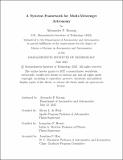| dc.contributor.advisor | de Weck, Olivier L. | |
| dc.contributor.advisor | Hewitt, Jacqueline N. | |
| dc.contributor.author | Koenig, Alexander P. | |
| dc.date.accessioned | 2024-04-17T21:11:38Z | |
| dc.date.available | 2024-04-17T21:11:38Z | |
| dc.date.issued | 2023-06 | |
| dc.date.submitted | 2023-06-16T11:28:12.747Z | |
| dc.identifier.uri | https://hdl.handle.net/1721.1/154207 | |
| dc.description.abstract | Multi-messenger (and more broadly, panchromatic) astronomy regards the use of multimodal information — incident photons, gravitational waves, neutrinos, and cosmic rays — to form astrophysical inferences. Since each messenger interacts uniquely with the dynamics of the phenomena in question, drawing information from multiple messengers poses a more complete probe of the universe. However, the exact inference method is scenario-specific, and we lack a general means to design multi-messenger instrument networks to best formulate scientific knowledge. To this end, this thesis presents a framework using probabilistic graph models to simulate the performance of heterogeneous instrument networks, with applications to two case studies.
The first case study regards the measurement of the Hubble parameter, i.e. the rate of expansion of the universe, with joint gravitational-wave and electromagnetic detection of neutron star mergers — cosmological standard sirens. This case study predicts [formula] joint detections by the end of the 2020s, likely sufficient to measure the Hubble parameter with 4% uncertainty. Furthermore, 𝒪(10⁵) instrument networks are simulated. The most promising configurations rely on a highly-sensitive set of ground-based interferometers with wide geographic distribution along with a set of narrow-field, large-aperture ground- or space-based telescopes.
The second case study regards using star tracker imagery from LEO satellite constellations to improve our knowledge of resident space objects Ð active satellites and debris. Traditionally, orbit determination relies on bespoke ground-based radar systems which are increasingly insufficient to meet the needs of LEO satellite operators. For two simulated objects, this case study shows star trackers could supplement but not replace radars to improve knowledge: including imagery from 10³ satellites could reduce positional uncertainty by a factor of ∼3 compared to a radar-only network. | |
| dc.publisher | Massachusetts Institute of Technology | |
| dc.rights | In Copyright - Educational Use Permitted | |
| dc.rights | Copyright MIT | |
| dc.rights.uri | http://rightsstatements.org/page/InC-EDU/1.0/ | |
| dc.title | A Systems Framework for Multi-Messenger
Astronomy | |
| dc.type | Thesis | |
| dc.description.degree | S.M. | |
| dc.contributor.department | Massachusetts Institute of Technology. Department of Aeronautics and Astronautics | |
| dc.identifier.orcid | https://orcid.org/0009-0007-2896-4214 | |
| mit.thesis.degree | Master | |
| thesis.degree.name | Master of Science in Aeronautics and Astronautics | |
